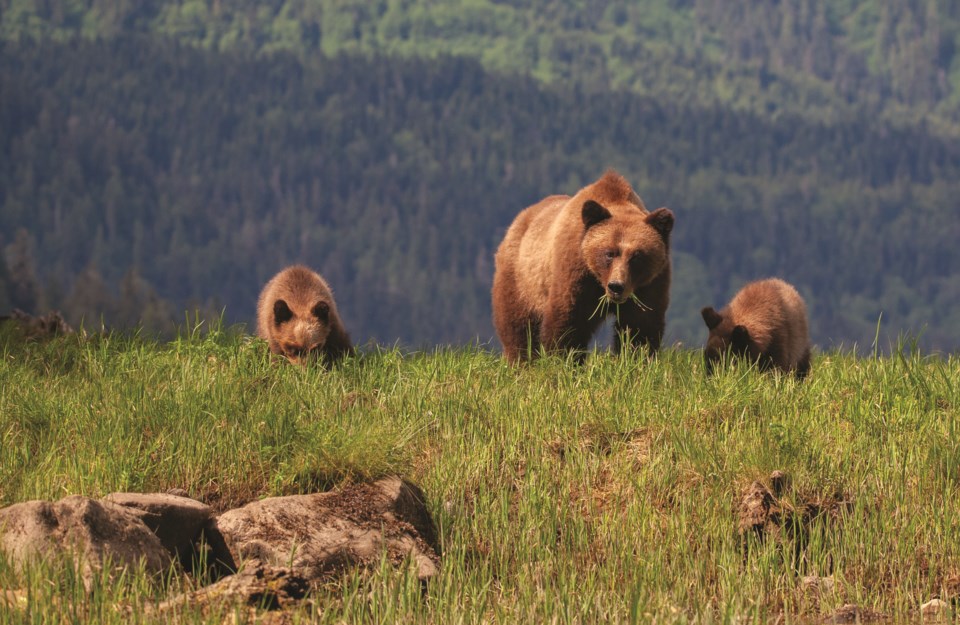As the conversation around grizzly bears continues in Whistler, new research is shining a light on how the species responds to human pressures.
In a study published July 6 in the Proceedings of the National Academy of Sciences, researchers concluded that human-dominated landscapes are highly lethal for grizzlies, particularly younger bears, and that as bears age, they avoid times when people are most active—in some cases even becoming nocturnal to avoid conflict.
“The studies showed us that bear mortality was very high near people … Most people would not be surprised by that, but it was especially high for younger bears, and that kind of led us to the question of, ‘Well why is that?’” said lead author Clayton Lamb, a University of Alberta biologist.
“What is it about an older bear that makes it able to better survive on the exact same landscape? It’s in the same footprints of a younger bear, but somehow it lives longer, so what is it about how that bear is using that landscape that allows it to live longer?”
The researchers found that the animals that survived had adapted to nocturnal patterns, reducing conflicts with humans by using more of the nighttime.
“So that kind of makes you think that the bears are actively responding to that risk at some point. It takes them a long time to learn how to do that, obviously, because a lot of them kinda don’t learn fast enough, and end up dying near people,” Lamb said.
While some bears adapt, “the mortality rates are faster than the learning rates,” he added.
“The mortality rates are so high near people that the persistence of bear numbers in these areas is really heavily reliant on bears kind of moving in or immigrating from adjacent secure habitat.”
The research provides a landscape-level look at carnivore co-existence in B.C., Lamb said, and shows how seemingly isolated incidents—like, say, a bear being put down after a conflict in your backyard—can have unseen ripple effects.
“These aren’t isolated systems; we don’t just lose one [bear] from the local area, because that local area is really only viable because it’s hooked into such a large landscape,” he said.
“So that effect ripples a long ways from towns, at a population level.”
Whistler has been grappling with the issue of a rebounding grizzly population in its alpine areas in recent years, as more and more people flock to newly opened alpine trails (see Pique, April 16, “RMOW goes back to drawing board on grizzly management”).
Whistler is in some ways catching up to places like Banff, Fernie and Sparwood in terms of grizzlies conflicting with recreation, said Bruce McLellan, a renowned B.C. researcher with more than four decades of experience, who also worked on the paper.
“It’ll be a challenge, but we’ve lived with challenges of grizzly bears and recreation in many, many areas. It just seems to be it’s new to Whistler because the population of grizzly bears in that area has really just … started to increase, it seems to me, in the last 10 or 15 years,” McLellan said.
“It’s doable, it’s just one little more dimension to think about when you’re doing things.”
But could Whistler’s Alpine Trail Network—with its thousands of annual users—damage the local grizzly population at a crucial moment?
There’s a risk of having some impact, McLellan said, and bears will react differently given the situation: some will shift to nocturnal patterns, and some won’t; some will leave, and some may become habituated.
“But as I say, lots of places deal with that, it’s just going to take more energy and more effort,” he said. “I mean, Yellowstone puts a huge amount of effort into keeping their bears around, and safe, as well as over 4 million people every year, so it’s doable.”
For Lamb, the research tells a “bittersweet” story: it’s positive to see bears making changes to survive, but the mortality rates near humans are discouraging.
“I’d say that even though it sounds a bit bleak at times, I think it’s interesting to know that grizzly bear populations are currently sustaining themselves near people in many places,” he said.
“They’re expanding in that Whistler area, and we’re seeing that in southwest Alberta and the eastern Okanagan near Big White … There’s a lot of areas that we’re seeing them slowly reclaim some of their previous historic range, and I think that’s largely due to some secure areas that are being looked after next door.”




